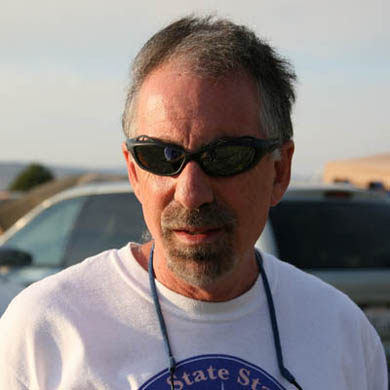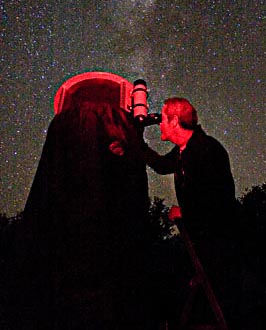 |
 |
|
Photo by Randy
Muller
|
|
|
Mark Wagner
Proprietor and Contributing Editor |
Steve Gottlieb
Head Observing Expert |
|
I started in the hobby as a kid, in the suburbs of the San Fernando Valley in Los Angeles. My parents bought me what I've come to learn was a 4.25" reflector. With it I saw stars that vibrated and changed colors, through the spectrum. I thought that was very cool. I saw Saturn. I must have been 12 years old. I thought I could see Saturn elongated without optical aid, back then. I lost interest in astronomy shortly thereafter, not to pick it up
again until college, when I took it as a science lecture and science
lab course. I went on a field trip to Glacier Point in Yosemite with
the class, unknowingly looked through John Dobson's telescope at a galaxy,
and asked myself "what's the big excitement". My interest
again waned when the class ended. My first telescope as an adult was a 10.1" f/4.5 Coulter Odessey. I had a great time sitting on my driveway in Los Gatos, sweeping the sky, looking for any sign of anything at all. I used the Edmonds' Mag 6 Atlas, and had some fun... for about a year. Then I heard people talking about Fremont Peak. I drove up, astonished at the road I had to take to get there. But I had a great time, and became a regular, even doing Fremont Peak Observatory Association public programs running the 30" Challenger telescope. Soon I moved up to a 14.5" f/5.6 Dob, loaned to me by a long time observing buddy, when he bought himself a 20" Obsession. I logged thousands of objects in that scope. I bought the 20" from my friend, owned it for 9 months, and found it too much work for the amount of gain over an 18". So, I ended up with an 18" Obsession, which I use to this day. I'm still very happy with it. I currently observe Hicksons, Abell Galaxy Clusters, Galaxy Trios, Abell Planetaries, Shakhbazian Galaxy Groups, targets on the Arp Catalog of Peculiar Galaxies, and anything that Steve comes up with! There's always something to do. I also volunteer at Lick Observatory on average a couple times a year. Its fun to do, and open to anyone who wants to, just by signing up. I am obviously an avid visual observer, usually seen with my 18" f/4.5 Obsession at star parties several times a month. Amateur telescope making captured my interest several years ago (the Coulter was first "under the knife", and I have since moved into commercial telescope making by designing and manufacturing the Compact Precision Telescope. I founded TAC in the mid 90's and participated in the founding of several parties including CalStar, the Mount Lassen Star Party, Nelms Star Party, SSP and (now the highlight of my astronomy year) the Golden State Star Party. One of the true highlights of my astronomy hobby was a in 2006, when
I traveled to Chile and met some of my astronomy friends for about ten
days of travel and observing in the country. You can read about the
trip on Ray Cash's web-page in the "Why
Chile" section, and get an idea about what we observed in his
observing
notes. Chile was a great place to go as culturally it was distinctly
different from our modern "Americanized" western society,
the sections I visited were extremes - as desolate as you can imagine
(beauty indeed walks a razor's edge) and, much like the Napa Valley
of my home state. And the people - in La Serena, Vicuna, Pisco Elqui
and Alcohuaz - they gave the place a soul that I've only seen represented
accurately in the movies "The Motorcycle Diaries" and "Machuca".
Viva Chile, heart and soul of the astronomy world! I live in San Jose, where mag 4 is a good night. So I travel far and wide within California for better skies. My local observing sites are primarily Henry Coe State Park, or private property sites like Willow Springs or Plettstone. I go on average twice a year to Mount Lassen Volcanic National Park and point more remote - to Adin, where GSSP is held, for the best skies I can easily get to. My other interests include the California wine country, hiking, live
theater, modern art, Sufi poetry, and Aikido to keep me sharp. But my
true passion is and will continue to be, visual astronomy. I enjoy the
hunt - as a star-hopper. I enjoy teasing out detail, moments of exquisite
seeing, and most of all - seeing others get out and enjoy the hobby
too... My life list is quite long. It will outlast me... Mark |
I live in the little town of Albany (1 square mile) just
north of Berkeley, California.  We
moved here when I my daughter entered kindergarten (she's now a PhD student
at UC Davis) because of the school district's good reputation and I ended
up loving the neighborhood and teaching Calculus at the high school just
3 blocks from home. We
moved here when I my daughter entered kindergarten (she's now a PhD student
at UC Davis) because of the school district's good reputation and I ended
up loving the neighborhood and teaching Calculus at the high school just
3 blocks from home.
I've had the astronomy bug since elementary school in Los Angeles and used to beg my parents to take me up to Griffith Park Observatory and later to buy me a telescope (they were hesitant as they figured it was a passing faze). I organized a little astronomy club with the kids on my block when I was 10 years old in 1959. The focus of the club was newspaper clippings I had collected of the early U.S. and Russian space launches as well as lectures I planned to give on the solar system and stars. I think that lasted two meetings before the kids I had corralled ran back to the schoolyard to play over-the-line baseball. Time passed, other interests flourished and then faded (my career as a professional Frisbee player is another story) until I discovered a 60mm refractor in 1976 languishing in my girlfriend's parents' garage. After a year setting it up in an open field in Lafayette and "discovering" many of the showpieces in Sagittarius, Scorpius, Cygnus, etc. without any guides or charts (and really no idea what they were), I started a subscription to Astronomy magazine and bought a copy of Edmund's mag 5 atlas. The small refractor was upgraded to a 6-inch reflector on an equatorial-fork mount and I was on my way systematically observing the Messiers and other showpieces in 1977. A year later I was seduced by a shiny orange C-8 with better optics and tracking, joined the San Francisco Amateur Astronomers and made it up a star party at Mt. Tamalpais where meet Bill Cherrington and had my first astonishing view of M51 through a large dobsonian. Soon afterwards I discovered Fremont Peak and was down there as often as possible (a long drive from my home in El Cerrito) from 1979 to 1983 when some of the regulars started complaining about light pollution (yes, even then) at the Peak and I was invited to join a group meeting at Bob Kestner's property (an optician who worked on the Hubble corrective optics) in the Sierra foothills at Fiddletown. By that point I was hooked on views through larger scopes and had purchased a 13.1" Odyssey I in late 1981 and by the end of 1984 had replaced it with a 17.5-inch monster. In the early to mid-1980's it wasn't easy obtaining information, images, and astronomical journal articles (nearly impossible in the pre-internet stone-age) so I thoroughly enjoyed heading over to the UC Berkeley Astronomy library (both on the first floor of Campbell Hall and the graduate library across the street) and comparing my observations at Fremont Peak or Fiddletown with the professional catalogues (UGC, CGCG, MCG, etc) and examining the actual Palomar Observatory Sky Survey prints which I used to pour over intently using a 10x magnifier, taking notes and making sketches of galaxy fields! I purchased several of the actual 11x14 contact prints from the Cal Tech bookstore in Pasadena which contained the fields of the Virgo Cluster, Perseus Cluster, Hercules Cluster etc. and these were by far the best finder charts available for tackling those galaxy clusters.
At the same time, I started to run across numerous errors and conflicting data in the professional and amateur literature, particularly with the fainter NGC objects and began corresponding with a couple of professional astronomers including cataloguer Harold Corwin at the University of Texas. As snail-mail evolved into e-mail and better communication with several amateurs/pros with a similar interest in historical visual astronomy, this turned into the NGC/IC Project that recently completed a historically correct revision of the entire NGC and IC. While visually checking a number of problem identities, I decided to dive head-on into the project and tackle the entire NGC as most of the discoveries were made by William Herschel and his son John using an 18.7-inch speculum-metal mirror (similar size though less light grasp than my 18-inch Starmaster). As of this date, I've tracked down and taken notes on over 6850 NGC's (many of these observed multiple times) with about 600 to go, mostly in the southern hemisphere. My visual notes on all these objects are available on this site. I'm hoping a few more trips to the southern hemisphere will finish up most of those remaining 600. While I was helping to sort out the NGC, I worked on correcting the databases in several computerized DSC's (digital setting circles) for Lumicon and Celestron. Later I put together the list of objects and wrote the descriptions for Orion's popular "Deep Map 600" folding star chart. Starting in the 1980's I began contributing observing articles to the former Deep Sky magazine and later to a couple of deep sky web sites including Adventures in Deep Space (originally hosted by Jim Shields) and Ray Cash's. Starting in 1999, I began observing articles for Sky & Telescope on topics such as observing Hickson Groups, Pisces-Perseus Supercluster, HII Regions in M101 and the Corona Borealis Galaxy Cluster as well as several articles for Astronomy Magazine on observing Supernova Remnants, Wolf-Rayet Nebulae, Winter Planetaries and more. Over the years I've never been enticed to get involved with imaging or ATM - for me it's always been about the aesthetics at the eyepiece in a large scope, the connection with nature and the mysteries of the universe and just relaxing and hanging out with buddies under a velvet-black night sky. Steve |

Original contributors with Steve Gottlieb: Jim Shields and Ray Cash
Original Photo by Tom Polakis

Questions, comments or suggestions? Contact us!

 Another
highlight is my daughter Mimi's interest in the hobby. Here she is as
Sky & Telescope's original "
Another
highlight is my daughter Mimi's interest in the hobby. Here she is as
Sky & Telescope's original "